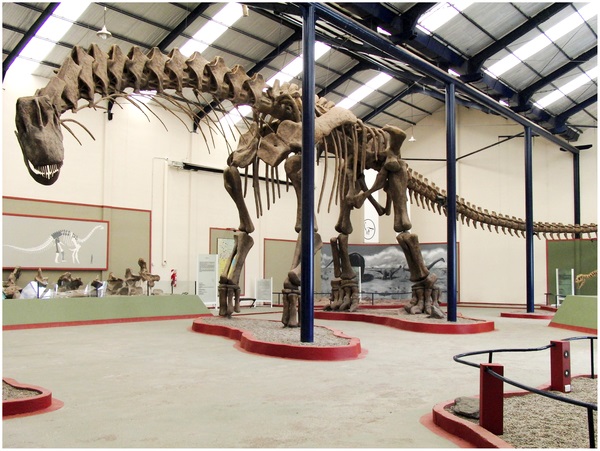 Argentinosaurus walks, with the help of supercomputers and simulation software.[/caption] Supercomputers that always seemed too geeky to be really "super" – at least in the five-year-old-boy meaning of the term – have finally done something worthwhile. Scientists at the University of Manchester in England figured out how the largest animal ever to walk on Earth actually walked on earth. Even better, that animal was a dinosaur – the 80-ton Argentinosaurus, a sauropod that lived in South America during the Late Cretaceous, about 95 million years ago. Researchers led by Bill Sellers, Rudolfo Coria and Lee Margetts at the N8 High Performance Computing facility in northern England used a 320 gigaflop/second SGI High Performance Computing Cluster supercomputer called Polaris to model the skeleton and movements of Argentinosaurus. The animal was able to reach a top speed of about 5 mph, with "a slow, steady gait," according to the team, whose paper describing dinosaur locomotion was published in scientific-research site PLOS ONE Oct. 30. (full paper PDF here.) Extrapolating from a few feet of bone, paleontologists were able to estimate the beast weighed between 80 and 100 tons and grew up to 115 feet in length. Polaris not only allowed the team to model the missing parts of the dinosaur and make them move, it did so quickly enough to beat the deadline for PLOS ONE Special Collection on Sauropods, a special edition of the site focusing on new research on sauropods that "is likely to be the 'de facto' international reference for Sauropods for decades to come," according to a statement from the N8 HPC center. The really exciting thing, according to Rodolfo Coria, a member of the team behind the first physical reconstruction of Argentinosaurus, was how well Polaris was able to fill in the gaps left by the fossil records. "It is frustrating there was so little of the original dinosaur fossilized, making any reconstruction difficult," he said, despite previous research that established some rules of weight distribution, movement and the limits of dinosaurs' biological strength. "The digitization of such vast dinosaur skeletons using laser scanners brings Walking with Dinosaurs to life…this is science not just animation." The team will also try to recreate the movement of other dinosaurs, including Tyrannosaurus Rex and, presumably, all the other digital stars of the Jurassic Park movies. Image: Sellers et al
Argentinosaurus walks, with the help of supercomputers and simulation software.[/caption] Supercomputers that always seemed too geeky to be really "super" – at least in the five-year-old-boy meaning of the term – have finally done something worthwhile. Scientists at the University of Manchester in England figured out how the largest animal ever to walk on Earth actually walked on earth. Even better, that animal was a dinosaur – the 80-ton Argentinosaurus, a sauropod that lived in South America during the Late Cretaceous, about 95 million years ago. Researchers led by Bill Sellers, Rudolfo Coria and Lee Margetts at the N8 High Performance Computing facility in northern England used a 320 gigaflop/second SGI High Performance Computing Cluster supercomputer called Polaris to model the skeleton and movements of Argentinosaurus. The animal was able to reach a top speed of about 5 mph, with "a slow, steady gait," according to the team, whose paper describing dinosaur locomotion was published in scientific-research site PLOS ONE Oct. 30. (full paper PDF here.) Extrapolating from a few feet of bone, paleontologists were able to estimate the beast weighed between 80 and 100 tons and grew up to 115 feet in length. Polaris not only allowed the team to model the missing parts of the dinosaur and make them move, it did so quickly enough to beat the deadline for PLOS ONE Special Collection on Sauropods, a special edition of the site focusing on new research on sauropods that "is likely to be the 'de facto' international reference for Sauropods for decades to come," according to a statement from the N8 HPC center. The really exciting thing, according to Rodolfo Coria, a member of the team behind the first physical reconstruction of Argentinosaurus, was how well Polaris was able to fill in the gaps left by the fossil records. "It is frustrating there was so little of the original dinosaur fossilized, making any reconstruction difficult," he said, despite previous research that established some rules of weight distribution, movement and the limits of dinosaurs' biological strength. "The digitization of such vast dinosaur skeletons using laser scanners brings Walking with Dinosaurs to life…this is science not just animation." The team will also try to recreate the movement of other dinosaurs, including Tyrannosaurus Rex and, presumably, all the other digital stars of the Jurassic Park movies. Image: Sellers et al Supercomputer Makes 80-Ton Dinosaur Walk
[caption id="attachment_13625" align="aligncenter" width="600"] Argentinosaurus walks, with the help of supercomputers and simulation software.[/caption] Supercomputers that always seemed too geeky to be really "super" – at least in the five-year-old-boy meaning of the term – have finally done something worthwhile. Scientists at the University of Manchester in England figured out how the largest animal ever to walk on Earth actually walked on earth. Even better, that animal was a dinosaur – the 80-ton Argentinosaurus, a sauropod that lived in South America during the Late Cretaceous, about 95 million years ago. Researchers led by Bill Sellers, Rudolfo Coria and Lee Margetts at the N8 High Performance Computing facility in northern England used a 320 gigaflop/second SGI High Performance Computing Cluster supercomputer called Polaris to model the skeleton and movements of Argentinosaurus. The animal was able to reach a top speed of about 5 mph, with "a slow, steady gait," according to the team, whose paper describing dinosaur locomotion was published in scientific-research site PLOS ONE Oct. 30. (full paper PDF here.) Extrapolating from a few feet of bone, paleontologists were able to estimate the beast weighed between 80 and 100 tons and grew up to 115 feet in length. Polaris not only allowed the team to model the missing parts of the dinosaur and make them move, it did so quickly enough to beat the deadline for PLOS ONE Special Collection on Sauropods, a special edition of the site focusing on new research on sauropods that "is likely to be the 'de facto' international reference for Sauropods for decades to come," according to a statement from the N8 HPC center. The really exciting thing, according to Rodolfo Coria, a member of the team behind the first physical reconstruction of Argentinosaurus, was how well Polaris was able to fill in the gaps left by the fossil records. "It is frustrating there was so little of the original dinosaur fossilized, making any reconstruction difficult," he said, despite previous research that established some rules of weight distribution, movement and the limits of dinosaurs' biological strength. "The digitization of such vast dinosaur skeletons using laser scanners brings Walking with Dinosaurs to life…this is science not just animation." The team will also try to recreate the movement of other dinosaurs, including Tyrannosaurus Rex and, presumably, all the other digital stars of the Jurassic Park movies. Image: Sellers et al
Argentinosaurus walks, with the help of supercomputers and simulation software.[/caption] Supercomputers that always seemed too geeky to be really "super" – at least in the five-year-old-boy meaning of the term – have finally done something worthwhile. Scientists at the University of Manchester in England figured out how the largest animal ever to walk on Earth actually walked on earth. Even better, that animal was a dinosaur – the 80-ton Argentinosaurus, a sauropod that lived in South America during the Late Cretaceous, about 95 million years ago. Researchers led by Bill Sellers, Rudolfo Coria and Lee Margetts at the N8 High Performance Computing facility in northern England used a 320 gigaflop/second SGI High Performance Computing Cluster supercomputer called Polaris to model the skeleton and movements of Argentinosaurus. The animal was able to reach a top speed of about 5 mph, with "a slow, steady gait," according to the team, whose paper describing dinosaur locomotion was published in scientific-research site PLOS ONE Oct. 30. (full paper PDF here.) Extrapolating from a few feet of bone, paleontologists were able to estimate the beast weighed between 80 and 100 tons and grew up to 115 feet in length. Polaris not only allowed the team to model the missing parts of the dinosaur and make them move, it did so quickly enough to beat the deadline for PLOS ONE Special Collection on Sauropods, a special edition of the site focusing on new research on sauropods that "is likely to be the 'de facto' international reference for Sauropods for decades to come," according to a statement from the N8 HPC center. The really exciting thing, according to Rodolfo Coria, a member of the team behind the first physical reconstruction of Argentinosaurus, was how well Polaris was able to fill in the gaps left by the fossil records. "It is frustrating there was so little of the original dinosaur fossilized, making any reconstruction difficult," he said, despite previous research that established some rules of weight distribution, movement and the limits of dinosaurs' biological strength. "The digitization of such vast dinosaur skeletons using laser scanners brings Walking with Dinosaurs to life…this is science not just animation." The team will also try to recreate the movement of other dinosaurs, including Tyrannosaurus Rex and, presumably, all the other digital stars of the Jurassic Park movies. Image: Sellers et al
 Argentinosaurus walks, with the help of supercomputers and simulation software.[/caption] Supercomputers that always seemed too geeky to be really "super" – at least in the five-year-old-boy meaning of the term – have finally done something worthwhile. Scientists at the University of Manchester in England figured out how the largest animal ever to walk on Earth actually walked on earth. Even better, that animal was a dinosaur – the 80-ton Argentinosaurus, a sauropod that lived in South America during the Late Cretaceous, about 95 million years ago. Researchers led by Bill Sellers, Rudolfo Coria and Lee Margetts at the N8 High Performance Computing facility in northern England used a 320 gigaflop/second SGI High Performance Computing Cluster supercomputer called Polaris to model the skeleton and movements of Argentinosaurus. The animal was able to reach a top speed of about 5 mph, with "a slow, steady gait," according to the team, whose paper describing dinosaur locomotion was published in scientific-research site PLOS ONE Oct. 30. (full paper PDF here.) Extrapolating from a few feet of bone, paleontologists were able to estimate the beast weighed between 80 and 100 tons and grew up to 115 feet in length. Polaris not only allowed the team to model the missing parts of the dinosaur and make them move, it did so quickly enough to beat the deadline for PLOS ONE Special Collection on Sauropods, a special edition of the site focusing on new research on sauropods that "is likely to be the 'de facto' international reference for Sauropods for decades to come," according to a statement from the N8 HPC center. The really exciting thing, according to Rodolfo Coria, a member of the team behind the first physical reconstruction of Argentinosaurus, was how well Polaris was able to fill in the gaps left by the fossil records. "It is frustrating there was so little of the original dinosaur fossilized, making any reconstruction difficult," he said, despite previous research that established some rules of weight distribution, movement and the limits of dinosaurs' biological strength. "The digitization of such vast dinosaur skeletons using laser scanners brings Walking with Dinosaurs to life…this is science not just animation." The team will also try to recreate the movement of other dinosaurs, including Tyrannosaurus Rex and, presumably, all the other digital stars of the Jurassic Park movies. Image: Sellers et al
Argentinosaurus walks, with the help of supercomputers and simulation software.[/caption] Supercomputers that always seemed too geeky to be really "super" – at least in the five-year-old-boy meaning of the term – have finally done something worthwhile. Scientists at the University of Manchester in England figured out how the largest animal ever to walk on Earth actually walked on earth. Even better, that animal was a dinosaur – the 80-ton Argentinosaurus, a sauropod that lived in South America during the Late Cretaceous, about 95 million years ago. Researchers led by Bill Sellers, Rudolfo Coria and Lee Margetts at the N8 High Performance Computing facility in northern England used a 320 gigaflop/second SGI High Performance Computing Cluster supercomputer called Polaris to model the skeleton and movements of Argentinosaurus. The animal was able to reach a top speed of about 5 mph, with "a slow, steady gait," according to the team, whose paper describing dinosaur locomotion was published in scientific-research site PLOS ONE Oct. 30. (full paper PDF here.) Extrapolating from a few feet of bone, paleontologists were able to estimate the beast weighed between 80 and 100 tons and grew up to 115 feet in length. Polaris not only allowed the team to model the missing parts of the dinosaur and make them move, it did so quickly enough to beat the deadline for PLOS ONE Special Collection on Sauropods, a special edition of the site focusing on new research on sauropods that "is likely to be the 'de facto' international reference for Sauropods for decades to come," according to a statement from the N8 HPC center. The really exciting thing, according to Rodolfo Coria, a member of the team behind the first physical reconstruction of Argentinosaurus, was how well Polaris was able to fill in the gaps left by the fossil records. "It is frustrating there was so little of the original dinosaur fossilized, making any reconstruction difficult," he said, despite previous research that established some rules of weight distribution, movement and the limits of dinosaurs' biological strength. "The digitization of such vast dinosaur skeletons using laser scanners brings Walking with Dinosaurs to life…this is science not just animation." The team will also try to recreate the movement of other dinosaurs, including Tyrannosaurus Rex and, presumably, all the other digital stars of the Jurassic Park movies. Image: Sellers et al 
